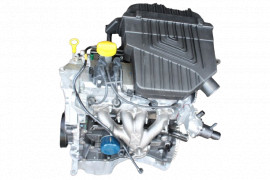Opel Corsa Engine: Whatever You Need to Know Before Buying
Opel Corsa Engine: Whatever You Need to Know Before Buying
Blog Article
Extensive Examination of the Mechanical Parts of a Hatchback's Electric motor
Understanding the elaborate functions of a hatchback's electric motor is similar to unwinding a complicated puzzle where every item plays an important function in the general efficiency of the lorry. opel corsa engine. From the synchronized movements of cylinders and pistons to the exact timing of camshafts and crankshafts, each part operates in harmony to power the vehicle. Nevertheless, what really sets an electric motor apart hinges on the better details - the delicate dancing of shutoffs and timing belts, the specific distribution of gas through injectors, and the stimulate that ignites everything via stimulate plugs. As we look into the internal functions of these mechanical wonders, a much deeper gratitude for the harmony of parts that drive a hatchback onward emerges.
Pistons and Cylinders

The efficiency and performance of a hatchback's engine rely heavily on the smooth operation of the pistons and cyndrical tubes. Appropriate securing in between the piston rings and cyndrical tube wall surfaces is essential to preserve compression and protect against loss of power. Furthermore, the size and layout of the cyndrical tubes straight influence the engine's displacement and total power output. Normal maintenance and tracking of these components are important to guarantee ideal engine performance and longevity.
Crankshafts and camshafts
Camshafts and crankshafts play important roles in the procedure of a hatchback's internal combustion engine, helping with exact timing and conversion of direct motion into rotational energy. The camshaft, situated within the engine block, regulates the opening and closing of the engine shutoffs at specific intervals. opel corsa engine.
Any type of misalignment or malfunction in these components can lead to engine efficiency issues and prospective damage. Routine upkeep and timely substitutes are necessary to make sure the smooth operation of these essential engine components in a hatchback.
Valves and Timing Belts
Playing an essential duty in the synchronization and operation of a hatchback's internal burning engine, the valves and timing belts operate in combination with the crankshafts and camshafts to make sure optimal efficiency. Shutoffs regulate the flow of air and gas into the combustion chamber while removing exhaust gases. The timing belt, also understood as the web cam belt, integrates the turning of the camshaft and crankshaft, making certain that the valves open and close at the correct times in regard to the piston position. Appropriate timing is critical for the engine to work successfully and avoid damages because of interference in between moving parts.

Fuel Injectors and Spark Plugs
Gas injectors and trigger plugs are essential components in a hatchback's engine system, liable for the efficient delivery of gas and ignition of the air-fuel mix. Modern hatchbacks typically utilize digital gas injection systems that can change fuel delivery based on various elements such as engine temperature, tons, and rate.
Correctly operating spark plugs are vital for engine efficiency, gas effectiveness, and discharges control. Normal assessment and upkeep of both gas injectors and stimulate plugs are necessary to ensure the engine operates efficiently and successfully.
Cooling System and Lubrication
Provided the crucial role of preserving ideal engine performance and efficiency in a hatchback, the cooling system and lubrication systems are important components that ensure correct operating and long life of the vehicle. The lubrication system in a hatchback consists of the oil pump, oil filter, and various lubes that lower rubbing within the engine. With each other, the cooling system and lubrication devices play a vital duty in keeping the hatchback's engine running smoothly and successfully.
Conclusion

Pistons and cylinders are integral parts within the interior burning engine of a hatchback, liable for transforming gas right into mechanical energy. The camshaft, located within the engine block, regulates the opening and closing of the engine shutoffs at particular intervals.Playing a critical duty in the synchronization and procedure of a hatchback's internal burning engine, the valves and timing belts work in conjunction with the crankshafts and camshafts to guarantee see post ideal efficiency.Fuel injectors and trigger plugs are critical components in a hatchback's engine system, liable for the efficient distribution of fuel and ignition of the air-fuel combination. Modern hatchbacks frequently use electronic fuel shot systems that can change gas distribution based on various factors such as engine lots, rate, and temperature.
Report this page